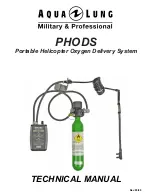
4
4.2-1 ADHESIVE MOUNT REMOVAL
(other than wax)
Caution:
It is usually difficult or near impossible to
remove a direct adhesive mounted high sensitivity DC
transducer without damaging it. That is, adhesive mounted
with cyanoacrylate or epoxy, without use of an
intermediary mounting base. However, adhesive mounting
is often used for temporary installation or when the test
object surface cannot be adequately prepared for screw
mounting.
NOTE: A chemical debonder should always be used to
avoid sensor damage. Care should be exercised to avoid
excessive force being applied to case body during
removal.
To avoid damaging the accelerometer, a de-bonding agent
must be applied to the adhesive prior to sensor removal.
With so many adhesives in use (everything from super
glues, dental cement, epoxies, etc), there is no universal
de-bonding agent available. The de-bonder for the Loctite
454 adhesive that PCB offers is Acetone. If you are using
anything other than Loctite 454, you will have to check
with the individual manufacturers for their de-bonding
recommendations. The de-bonding agent must be allowed
to penetrate the surface in order to properly react with the
adhesive, so it is advisable to wait a few minutes before
removing the sensor.
After the de-bonding agent has softened the adhesive, use
a gentle shearing (or twisting) motion (by hand only) to
remove the sensor from the test structure.
5.0 CABLING
5.1 Units with integral connectors
Care and attention to cable installation and cable
condition is essential as the reliability and accuracy of any
measurement system is no better than that of its weakest
link. Due to the nature of vibration and shock
measurements, all sensor cables will ultimately fatigue
and fail. Good installation practice will extend the life of
a cable, however, it is highly recommended to keep spare
cables on hand to enable continuation of the test in the
event of a cable failure.
STEP 1:
Ascertain that you have the correct cable type.
Note: Most high sensitivity DC accelerometers have
integral cable connections; therefore the cable leads at the
opposite end from the accelerometer are the main focus
and will apply to the specific connector plugs associated
with follow-on electronics/signal conditioning equipment.
One cable type cannot satisfy all applications. Industrial
applications often require shielded, twisted-pair cables to
reduce the effects of EMI and RFI that is present near
electrical motors and machinery. Teflon-jacketed cabling
may be necessary to withstand corrosive environments
and higher temperatures. Feel free to contact a factory
representative for a specific recommendation on cables
that are best suited for your application.
STEP 2:
Connect the cable to the accelerometer.
A small amount of thread-locking compound placed on
the connector threads prior to attachment helps secure the
cable during testing. In wet, oily, or dirty environments,
the connection can be sealed with silicone rubber sealant,
O-rings, and flexible, heat-shrink tubing.
Multi-Conductor Cables:
Make accelerometer cable
connection to appropriate connector plug via soldering or
crimping leads to plug sockets. Specific instructions for
this activity are completely dependant on the plug
required (D-sub, circular, Lemo, Fischer, etc.) to mate to
follow-on conditioning equipment’s input receptacle.
Refer to instrumentation interface guidelines for proper
mating of accelerometer cabling.
Pigtail Connections:
Certain high sensitivity DC
accelerometers are provided with lightweight cables
having “Pigtail” connections. This type of connection
reduces overall weight and incidence of connection
intermittency under shock conditions. In the event of a
cable or connection failure, the cables may be repaired in
the field simply by re-soldering the stripped leads to the
exposed pins on the sensor. (Check the
Installation
Drawing
to determine pin functions). In many cases, it is
also helpful to protect the solder joint with heat-shrink
tubing or epoxy. It should be noted that cable breaks too
close to the accelerometer case, may not be repairable due
to insufficient cable material for repair.
NOTE: If you do not have the experience or resources to
attach pigtail leads, consult PCB to discuss factory
attachment. Damage to internal electronics may be
caused by excessive heat during soldering and such
failure is not covered by warranty.
STEP 3:
Route the cable to the signal conditioner, making
certain to relieve stress on the sensor/cable connection.
Also, minimize cable motion by securing it with tape,
clamps or ties at regular intervals.
Common sense should be used to avoid physical damage
and minimize electrical noise. For instance, avoid routing
cables near high-voltage wires. Do not route cables along
floors or walkways where they may be stepped on or
become contaminated. To avoid ground loops, shielded
cables should have the shield grounded at one end only,
typically at the signal conditioner.


































